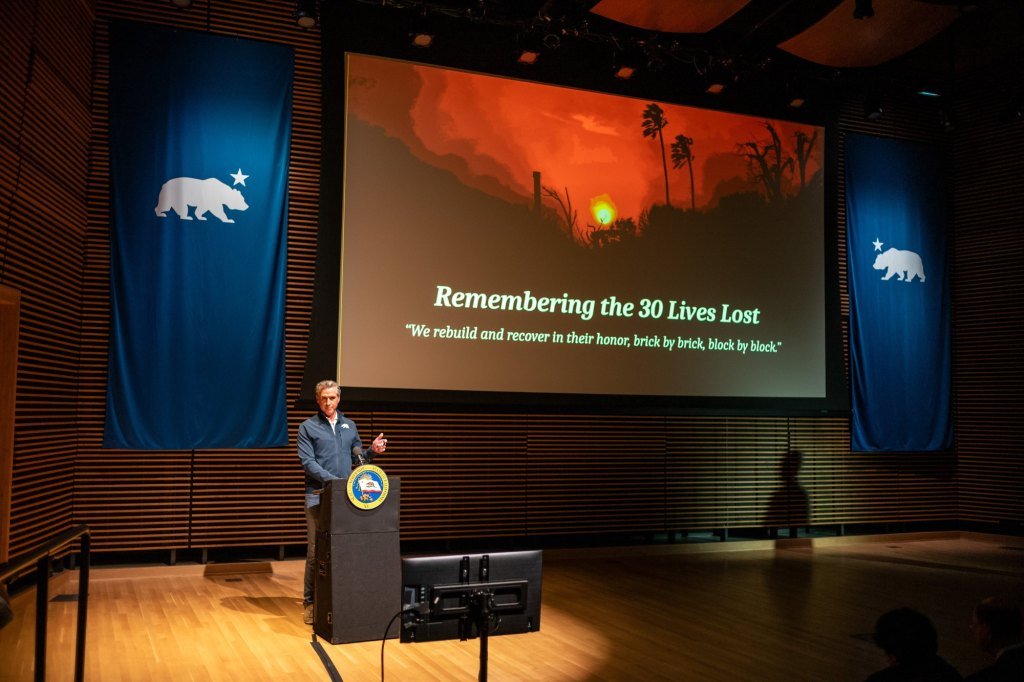Eaton and Palisades Fires: A Turning Point for Southern California Recovery
On a sweltering July day, the sound of somber remembrance echoed through the halls of Pasadena City College. Local leaders gathered alongside Governor Gavin Newsom to mark the six-month anniversary of the Eaton and Palisades fires—a stark reminder of the destruction that engulfed this vibrant region. As Newsom stood at the podium, flanked by officials including Senator Alex Padilla and Representatives Judy Chu and Brad Sherman, he delineated the path for rebuilding a community still defined by its trauma.
A Cataclysmic Event
The Eaton fire, which claimed 18 lives and ravaged over 14,000 acres, was a monumental crisis. The flames consumed approximately 9,400 structures across Altadena and nearby cities, leaving a deep scar not just on the landscape but also on the lives of residents. Similarly, the Palisades fire, which enveloped coastal regions, took 12 lives and destroyed 6,800 structures. Fueled by dry conditions and relentless 80 mph winds, these wildfires created an unprecedented emergency that overwhelmed firefighting efforts.
The Fear of Leaving
As six months have passed, the struggle to rebuild is layered with uncertainty. Surveys from the Urban Land Institute, in collaboration with USC and UCLA, reveal alarming statistics:
- 79% of Palisades homeowners intend to rebuild, but 70% may not return if the process extends beyond three years.
- In the Eaton area, 89% wish to rebuild, with 63% expressing similar concerns regarding timelines.
The profound psychological toll on residents cannot be overstated. “The fires scarred us emotionally and physically,” said local psychologist Dr. Helen Rivera. “Even as homes are rebuilt, the community grapples with the fear of loss and uncertainty.”
Government Response: A Pledge to Accelerate Rebuilding
Against this backdrop, Newsom emphasized the urgent need for collaborative efforts. “You want to go fast, you go alone. You want to go far, you go together,” he stated, articulating a vision for collective recovery. His administration’s latest executive order aims to expedite construction efforts, allowing exemptions to specific building codes that have traditionally delayed rebuilding processes.
Community Engagement
The press conference, deemed a call to collective action, did not arrive without its criticisms. The sudden presence of U.S. Immigration and Customs Enforcement (ICE) agents at nearby MacArthur Park during the event diverted attention from the recovery efforts initiated by local officials. Deputy Mayor Rachel Freeman, standing in for Los Angeles Mayor Karen Bass, noted the pivotal role immigrants play in construction sectors and the community-at-large. “This is a time for us to honor the commitment of our immigrant neighbors, whose labor is essential to rebuilding,” she declared.
Newsom echoed these sentiments, chastising the ICE actions as “cruel and weak,” referring to them as inappropriate during a time that should be focused on recovery and solidarity. He stated, “What a disgrace what’s happening at MacArthur Park… It’s nothing more than theater during a time of devastation.”
Navigating Complexities of Recovery
While the debris clearance navigates surprisingly swift completion—96% in the Eaton fire area and 89% in the Palisades—many residents still grapple with untold challenges. The normalization of looting, insurance claim delays, and the bureaucratic maze of federal disaster relief all compound their frustrations. “We’re stuck in limbo,” said fire victim Maria Gonzalez. “We can’t afford to rebuild if the insurance companies don’t step up.”
Insurance reimbursement levels often fall short of actual rebuilding costs, posing substantial roadblocks ahead. “There’s a major gap between what insurance covers and what it costs to rebuild from the ashes,” stated Dr. Samuel Tiberius, an urban planning expert. “This will profoundly impact the recovery landscape in Southern California.”
Environmental Concerns
A pressing concern involves the environmental ramifications of the fires and subsequent rebuilding. Protesters gathered outside the conference hall, holding signs demanding government action on contamination issues in fire-affected areas. “Toxic ground all around,” one sign read, encapsulating the struggle for health and safety in their communities.
Leaders like Newsom did not gloss over these concerns. He recognized the need for remediation efforts to ensure that residents can safely return home without facing environmental hazards. “Without addressing these environmental consequences, we are simply rebuilding on a foundation of ash and toxicity,” he asserted.
A Community in Transition
As Southern California stands amidst the rubble of the fires, leaders strive for a solution oriented toward rebuilding with speed and empathy. The complexities of recovery are underscored by fortifying community ties and addressing the fears and concerns of the residents who call this place home. Each day that passes is marked not just by progress but by the memories and losses that will linger long after the smoke has cleared.
As the focus now shifts toward recovery, the question remains: will the promises made amidst the rhetoric translate into a genuine and communal effort toward rebuilding lives, homes, and trust? The ghosts of the Eaton and Palisades fires will undoubtedly linger, but the active engagement from community leaders signals a collective yearning for healing.









